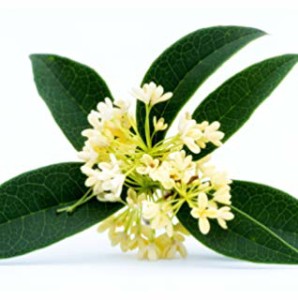
If you are hoping to grow an olive tree in eastern North America and proudly incorporate your homegrown fruits into martinis, tapenade, or empanadas, you are destined for disappointment. The handsome European olive—Olea europaea—needs a warm winter climate to produce its toothsome harvest.
But other members of the Oleaceae or olive family do flourish farther north. I ran into one the other day on a walk through a nearby park. The small tree in question bore handsome, glossy green leaves, each of which was two to five inches long, opposite on the stems and oval-shaped. The leaves told me the plant was likely an evergreen; but the flowers screamed “olive family”.
The small, clustered white blossoms exuded a fragrance that was noticeable from several feet away. My daughter thought it was reminiscent of ‘iced tea-lemonade”. To my nose the blooms smelled a little like jasmine. Perceptions of fragrance vary from person to person, but the sweet scent of olive family members is distinctive.
I wanted to know more. We collected a fallen twig, with leaves and flowers still attached, and took it home. I started research. Between reliable internet sources, like the Missouri Botanical Garden, and reference books, including the incomparable Manual of Woody Landscape Plants by Dr. Michael Dirr, emeritus professor at the University of Georgia, I found my way to the useful and decorative genus Osmanthus. Osmanthus is a card-carrying member of the olive family and home to some very good ornamental shrubs and small trees. I have one species in my front yard, Osmanthus heterophyllus or false holly. It is a medium-size shrub with green, prickly, holly-like leaves that are marbled in cream. If I didn’t trim it fairly regularly to maintain a respectable size, it would produce white, fragrant flower clusters in September. I know I am missing something by not allowing it to flower, but if it grew to its maximum height, I would be missing the front windows of my house. Every gardener makes compromises.
My research narrowed down the plant choices to two osmanthus species, Osmanthus fragrans, also known as fragrant tea olive, and Osmanthus americana, sometimes known as Cartrema americana. The latter also goes by devilwood, American olive or wild olive. Both species sport glossy ovoid leaves and extremely fragrant clusters of small white flowers. Both are evergreen and can be grown as shrubs or small trees.
What’s the difference between these two ornamental olives? The biggest difference is cold hardiness. Fragrant olive, native to the Himalayas and parts of Japan and China, is hardy only in USDA plant hardiness zones 8b-11, which means that winter minimum temperatures must remain above 20 degrees Fahrenheit. Even if you live in an area that rarely sees 20 degree winter temperatures, you still should be concerned about wind chill during the colder months. When in doubt, it’s best to grow your fragrant olive in a large container and move it indoors in winter.
Since the osmanthus that I saw in the local park was a mature specimen rising happily from the soil, I figured it could not be a fragrant olive. I live in USDA plant hardiness zone 7a, where minimum winter temperatures can occasionally sink to five degrees Fahrenheit, with wind chills that sometimes make the actual temperature much, much colder. It is highly unlikely that fragrant olive could survive in my climate for the number of winters it would take for it to reach mature size.
The osmanthus in the park is probably American olive or devilwood, native to the American southeast. People who look for secret meanings should be aware that the nickname does not come from any infernal associations. Osmanthus americanus produces extremely hard, unworkable wood, which has made generations of craftspeople invoke the devil when trying to cut and shape it into useful objects.
The wood may be problematic, but the tree is lovely. Each fragrant bloom is fused at the base to form a short trumpet. The scent and shape of the flower clusters is as alluring to pollinating insects as it is to humans. While I was sniffing the “devilwood” blooms, I was competing with a monarch butterfly, scores of skippers, various types of bees and a gorgeous, diurnal moth, the ailanthus webworm or Atteva aurea. The osmanthus was literally throbbing with life.
Perhaps best of all, the blooms appear in early fall and may continue all the way through until spring. This is a help to pollinators, not to mention humans in need of inspiration as the days grow shorter and darker.
As time goes on, I will watch the tree to see the long, dark purple to black fruits that succeed the flowers.
Michael Dirr says, “Devilwood is by no means a common landscape shrub, but deserves consideration…” If I could find a suitable site on my property, I would plant one without delay. In the meantime, I have ordered a small fragrant olive to grow outdoors in the warm months and indoors during the cold months.
| If you want to grow American olive, you may be hard-pressed to find a retailer that supplies it. You can order from Mail Order Natives, P. O. Box 9366, Lee, FL 32059: (850) 973-7371. www.mailordernatives.com. Free newsletter. For fragrant olive, try Logees, 141 North St, Danielson, CT 06239; (860) 774-8038, www.logees.com. Free print catalog. |
